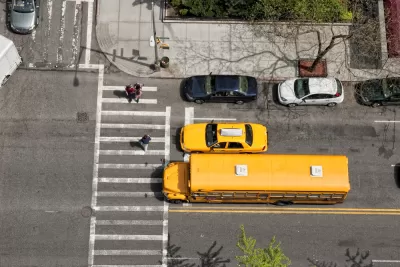Adam Millard-Ball guest blogs about a new article in the Journal of Planning Education and Research.

Guest Blogger: Adam Millard-Ball of the University of California, Santa Cruz.
Fast forward to the year 2050. Autonomous (self-driving) vehicles are the norm. Their original promises: drivers would be freed from a tedious chore, traffic collisions would be a relic of history, and congestion would be all but eliminated as vehicles communicated with each other to smooth out traffic.
In dense, urban centers, however, the reality of autonomous vehicles has transpired somewhat differently. Manhattan, San Francisco, and even downtown Phoenix are gridlocked. Pedestrians move freely throughout the streets, crossing at will. Children play basketball on residential streets.
What caused this new era of pedestrian supremacy? The answer lies in the commendable safety record of autonomous cars. Self-driving systems continuously scan for other road users. In the presence of an unpredictable child, a risk-averse autonomous car slows down and yields. At midblock and unmarked crosswalks, the car—programmed to obey the rules of the road—stops and waits for the pedestrian to cross.
In my new article in the Journal of Planning Education and Research, I use the economic game of "chicken" to help understand the interactions between pedestrians and cars. In the classic version of the game, two daredevil drivers speed toward each other. The winner: the driver who does not “chicken out” and swerve.
A similar game applies to encounters between cars and pedestrians at a crosswalk. On most streets today, pedestrians invariably yield to cars even when they have the right of way. Pedestrians have far more to lose from a collision, and the probability of an inattentive or intoxicated driver is, for most of us, too high to chance.
In a city dominated by autonomous vehicles, however, pedestrians have the upper hand. Provided that sight distances and speeds provide sufficient braking distance, they can cross with impunity. The pedestrian knows that the autonomous vehicle will not be drunk or distracted, and that it will follow the law.
A good way to win at chicken is to behave as a sociopath—one who prefers death to losing, and who will not swerve under any circumstances. Autonomous vehicles are incapable of such behavior. Pedestrians, on the other hand, gain an incentive to act unpredictably. They may just need to step into the street to force the risk-averse car to slow down. The same is true for cyclists, who are empowered to ride in traffic and “take the lane.”
What can planners learn from using game theory to formalize such a thought experiment? First, the safety and law-abiding nature of autonomous vehicles is likely to slow such cars down. It would take long enough to drive across Manhattan at rush hour while obeying all traffic laws to the letter. Now imagine the same experience with pedestrians crossing at will, and bicyclists cutting in front. In dense, urban centers, autonomous vehicles are at a speed disadvantage, and trips may shift to walking and cycling.
Second, most analyses have assumed autonomous vehicles will “play nice” and cooperate with each other. But this assumption may not match optimal private behavior. For example, traffic congestion could be worsened if autonomous vehicles cut in front of each other, safe in the knowledge that the other car will yield and brake.
Or consider the Super Bowl, where each spectator exiting the stadium instructs her autonomous car to time its arrival at the curb to minimize her wait. To achieve this, one option would be for the car to circle the block, creeping slowly along the final block at the minimum possible speed in the hopes that its owner would emerge. For one vehicle to do this would be annoying. Gridlock would result if all 70,000 Super Bowl attendees did the same.
The ultimate impacts of autonomous vehicles depend not only on technological advances and market adoption, but also on how planners and policy makers respond. One approach would be to maintain traffic speeds by eliminating crosswalks, erecting fences between the sidewalk and roadway to corral pedestrians, and stepping up enforcement against jaywalkers.
Alternatively, planners could seize the opportunity to create more pedestrian-oriented streets, and relegate drop-offs to the fringes of urban commercial districts. Paradoxically, autonomous vehicles could usher in a new era of pedestrian supremacy.
This blog post is adapted from Millard-Ball, A., 2016. "Pedestrians, Autonomous Vehicles and Cities." Journal of Planning Education and Research. Open Access Until November 26th, 2016

Trump Administration Could Effectively End Housing Voucher Program
Federal officials are eyeing major cuts to the Section 8 program that helps millions of low-income households pay rent.

Planetizen Federal Action Tracker
A weekly monitor of how Trump’s orders and actions are impacting planners and planning in America.

Canada vs. Kamala: Whose Liberal Housing Platform Comes Out on Top?
As Canada votes for a new Prime Minister, what can America learn from the leading liberal candidate of its neighbor to the north?

Washington State’s Parking Reform Law Could Unlock ‘Countless’ Acres for New Housing
A law that limits how much parking cities can require for residential amd commercial developments could lead to a construction boom.

Wildlife Rebounds After the Eaton Fire
Following the devastation of the Eaton Fire, the return of wildlife and the regrowth of native plants are offering powerful signs of resilience and renewal.

LA to Replace Inglewood Light Rail Project With Bus Shuttles
LA Metro says the change is in response to community engagement and that the new design will be ready before the 2028 Olympic Games.
Urban Design for Planners 1: Software Tools
This six-course series explores essential urban design concepts using open source software and equips planners with the tools they need to participate fully in the urban design process.
Planning for Universal Design
Learn the tools for implementing Universal Design in planning regulations.
Central Transportation Planning Staff/Boston Region MPO
Heyer Gruel & Associates PA
Institute for Housing and Urban Development Studies (IHS)
City of Grandview
Harvard GSD Executive Education
Regional Transportation Commission of Southern Nevada
Toledo-Lucas County Plan Commissions






























